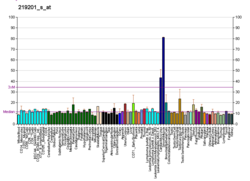| TWSG1 |
|---|
|
| Identifiers |
|---|
| Aliases | TWSG1, TSG, twisted gastrulation BMP signaling modulator 1 |
|---|
| External IDs | OMIM: 605049; MGI: 2137520; HomoloGene: 10774; GeneCards: TWSG1; OMA:TWSG1 - orthologs |
|---|
| Gene location (Human) |
|---|
 | | Chr. | Chromosome 18 (human)[1] |
|---|
| | Band | 18p11.22 | Start | 9,334,767 bp[1] |
|---|
| End | 9,402,420 bp[1] |
|---|
|
| Gene location (Mouse) |
|---|
 | | Chr. | Chromosome 17 (mouse)[2] |
|---|
| | Band | 17 E1.1|17 35.26 cM | Start | 66,228,967 bp[2] |
|---|
| End | 66,258,221 bp[2] |
|---|
|
| RNA expression pattern |
|---|
| Bgee | | Human | Mouse (ortholog) |
|---|
| Top expressed in | - seminal vesicula
- cartilage tissue
- germinal epithelium
- caput epididymis
- corpus epididymis
- tibia
- tail of epididymis
- visceral pleura
- parietal pleura
- Descending thoracic aorta
|
| | Top expressed in | - cumulus cell
- tail of embryo
- ascending aorta
- aortic valve
- medullary collecting duct
- genital tubercle
- corneal stroma
- efferent ductule
- right ventricle
- molar
|
| | More reference expression data |
|
|---|
| BioGPS |  | | More reference expression data |
|
|---|
|
| Gene ontology |
|---|
| Molecular function | - protein binding
- transforming growth factor beta binding
| | Cellular component | - extracellular region
- extracellular space
| | Biological process | - negative regulation of BMP signaling pathway
- multicellular organism development
- mesoderm formation
- cell differentiation
- forebrain development
- camera-type eye development
- salivary gland morphogenesis
- BMP signaling pathway
- ossification
- negative regulation of osteoblast differentiation
- tissue development
- positive regulation of BMP signaling pathway
- negative regulation of cytokine production
- transforming growth factor beta receptor signaling pathway
- positive regulation of pathway-restricted SMAD protein phosphorylation
- negative regulation of CD4-positive, alpha-beta T cell activation
- negative regulation of CD4-positive, alpha-beta T cell proliferation
- hemopoiesis
| | Sources:Amigo / QuickGO |
|
| Orthologs |
|---|
| Species | Human | Mouse |
|---|
| Entrez | | |
|---|
| Ensembl | | |
|---|
| UniProt | | |
|---|
| RefSeq (mRNA) | | |
|---|
| RefSeq (protein) | | |
|---|
| Location (UCSC) | Chr 18: 9.33 – 9.4 Mb | Chr 17: 66.23 – 66.26 Mb |
|---|
| PubMed search | [3] | [4] |
|---|
|
| Wikidata |
| View/Edit Human | View/Edit Mouse |
|

















